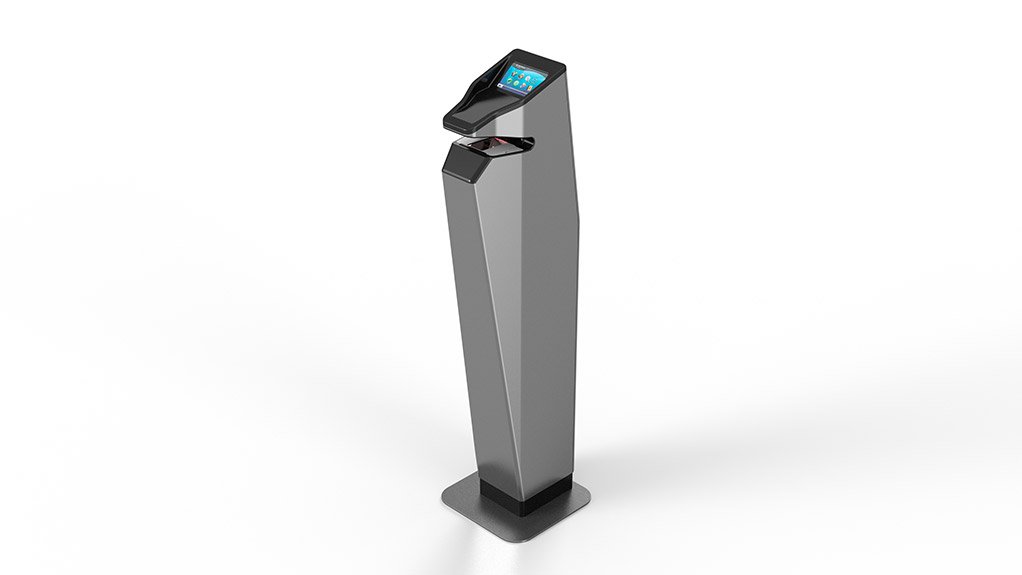Biometric and security solutions provider Morpho South Africa (SA) introduced its contactless MorphoWave tower and MorphoWave desktop fingerprint scanners to the South African market at this year’s Securex South Africa security and fire exhibition, which took place at the Gallagher Convention Centre from May 12 to 14.
Sub-Saharan Africa security division sales manager Nicolas Garcia tells Engineering News that the MorphoWave scanners, which were developed and manufactured in France, are the first contactless scanners of their kind, capable of scanning and matching the fingerprints of four fingers in less than a second.
Garcia says users simply wave their hand above the sensor to be identified, adding that the tower scanner, using MorphoManager software, can capture and store the personal details, image and fingerprints of more than 10 000 people.
One of the scanner’s main applications is identifying people in high traffic areas, such as airports, train stations and embassies. Garcia points out that it can be used for verification, authentication and identification purposes and that it is, consequently, also effective for restricting and controlling access to secure areas.
Aside from its speed and access throughput – which is about 1 000 people an hour depending on the setting – the main advantage of the scanner is that it is hygienic. As it is contactless, the scanner’s surface remains clean and users need not worry about contact transmission, or direct and indirect bodily contact that transmits microbes, in places such as Ebola zones.
Garcia says both scanners use optical imaging technology to capture a digital image of the fingerprints for the sake of comparison and, thus, identification.
He notes that the products were primarily designed for system integrators, who would use the Morpho hardware and incorporate it into a security system. “Morpho does not believe that its customers should adapt to its products. Rather, its products should adapt to its customers,” says Garcia, adding that, since Morpho’s products are easily integrated, they are able to suit the customer’s individual needs
He further stresses that system integration is ideal and that, while the MorphoWave range can be used as standalone products, they are more effective when incorporated into a system.
Garcia explains that, if calibrated to the security system according to the client’s requirements, the MorphoWave tower, for example, can be installed at an entry point. “Once it identifies and verifies an employee’s right to access the building, it can communicate, through middleware, to the electronic turnstile/barrier/door that this person is allowed to enter, while restricting access to areas that certain employees are not allowed to enter.”
Meanwhile, he notes that there have been two key trends in biometrics over the last two years and that Morpho has always tried to keep abreast of any changes when developing products.
Convergence
In recent years, companies have come to understand that they cannot have a complete security system if they only use one product, which has prompted companies to start merging technologies.
Another facet of convergence is between physical access control and logical access control. He explains that nowadays, with the MorphoWave or other biometric technology, the physical device can, for example, virtually access the network and allow employees access depending on what information is stored on MorphoManager.
“The system is aware that, logically, an employee should not be able to access his/hers desktop if he/she hasn’t entered the building. This means that the system prevents desktop devices from being accessed remotely outside the building, which adds another layer of security,” adds Garcia.
Mobility
Garcia highlights the demand for mobile terminals as another key trend in the security technology industry, as clients with remote sites that are not necessarily connected to the grid, or with insufficient infrastructure, can still have identification services on site.
Secondly, visitor management becomes easier with a mobile scanner and, lastly, mobile scanners can be used for spot-checking in sensitive or restricted areas.
Garcia says he believes that demand for mobile terminals will increase in Africa. This is because more African countries are improving their infrastructure, which means that their need to control access to certain government facilities, businesses or entities becomes greater. Companies are also interested in having the best possible technology, and Morpho aims to assist on that level, concludes Garcia.
Edited by: Samantha Herbst
Creamer Media Deputy Editor
EMAIL THIS ARTICLE SAVE THIS ARTICLE
To subscribe email subscriptions@creamermedia.co.za or click here
To advertise email advertising@creamermedia.co.za or click here













